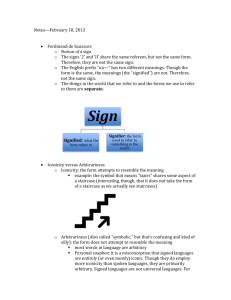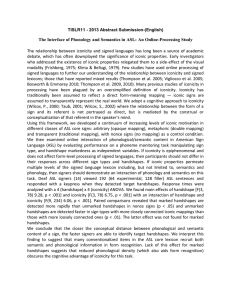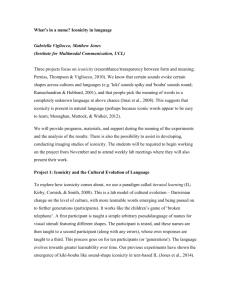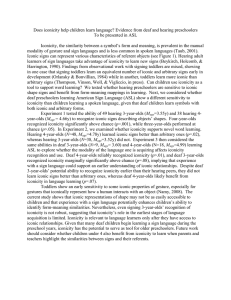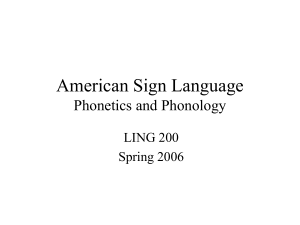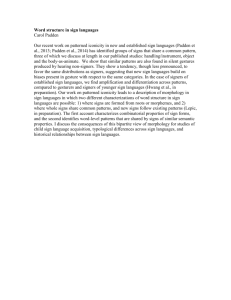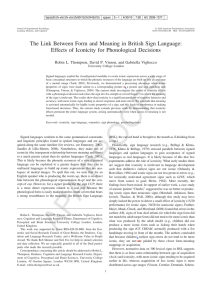Title: The question of the role iconicity plays in ASL acquisition... language research suggested that children's acquisition of sign language is...
advertisement
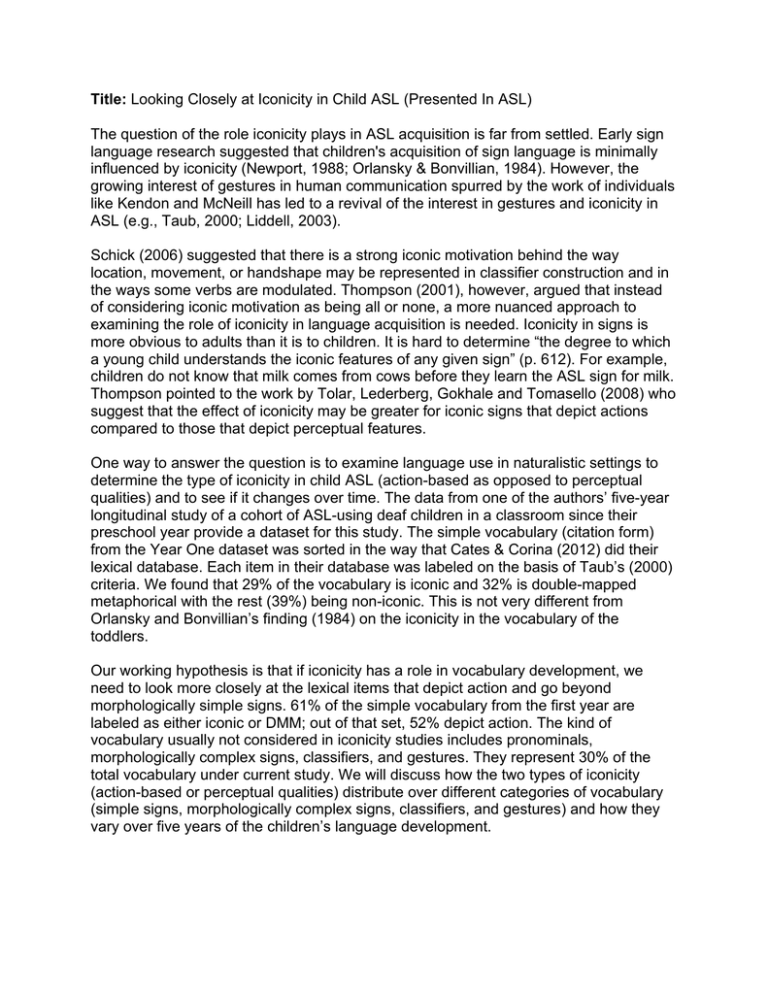
Title: Looking Closely at Iconicity in Child ASL (Presented In ASL) The question of the role iconicity plays in ASL acquisition is far from settled. Early sign language research suggested that children's acquisition of sign language is minimally influenced by iconicity (Newport, 1988; Orlansky & Bonvillian, 1984). However, the growing interest of gestures in human communication spurred by the work of individuals like Kendon and McNeill has led to a revival of the interest in gestures and iconicity in ASL (e.g., Taub, 2000; Liddell, 2003). Schick (2006) suggested that there is a strong iconic motivation behind the way location, movement, or handshape may be represented in classifier construction and in the ways some verbs are modulated. Thompson (2001), however, argued that instead of considering iconic motivation as being all or none, a more nuanced approach to examining the role of iconicity in language acquisition is needed. Iconicity in signs is more obvious to adults than it is to children. It is hard to determine “the degree to which a young child understands the iconic features of any given sign” (p. 612). For example, children do not know that milk comes from cows before they learn the ASL sign for milk. Thompson pointed to the work by Tolar, Lederberg, Gokhale and Tomasello (2008) who suggest that the effect of iconicity may be greater for iconic signs that depict actions compared to those that depict perceptual features. One way to answer the question is to examine language use in naturalistic settings to determine the type of iconicity in child ASL (action-based as opposed to perceptual qualities) and to see if it changes over time. The data from one of the authors’ five-year longitudinal study of a cohort of ASL-using deaf children in a classroom since their preschool year provide a dataset for this study. The simple vocabulary (citation form) from the Year One dataset was sorted in the way that Cates & Corina (2012) did their lexical database. Each item in their database was labeled on the basis of Taub’s (2000) criteria. We found that 29% of the vocabulary is iconic and 32% is double-mapped metaphorical with the rest (39%) being non-iconic. This is not very different from Orlansky and Bonvillian’s finding (1984) on the iconicity in the vocabulary of the toddlers. Our working hypothesis is that if iconicity has a role in vocabulary development, we need to look more closely at the lexical items that depict action and go beyond morphologically simple signs. 61% of the simple vocabulary from the first year are labeled as either iconic or DMM; out of that set, 52% depict action. The kind of vocabulary usually not considered in iconicity studies includes pronominals, morphologically complex signs, classifiers, and gestures. They represent 30% of the total vocabulary under current study. We will discuss how the two types of iconicity (action-based or perceptual qualities) distribute over different categories of vocabulary (simple signs, morphologically complex signs, classifiers, and gestures) and how they vary over five years of the children’s language development. References: Cates, D. & Corina, D. (2012). Location, location, location: The relationship between form and meaning in the lexicon of American Sign Language. Unpublished manuscript. Liddell, S. (2003). Grammar, gesture, and meaning in American Sign Language. Cambridge University Press: New York. Newport, E.L. (1988). Constraints on Learning and Their Role in Language Acquisition: Studies of the Acquisition of American Sign Language. Language Sciences, 10(1), 147-172. Orlansky, M.D & Bonvillian, J.D. (1984). The role of iconicity in early sign language acquisition. Journal of Speech and Hearing Disorders, 49, 287-292. Schick, B. (2006). Acquiring a visually motivated language: Evidence from diverse learners. In B. Schick, M. Marschark, & P. Spencer (Eds.), Advances in the sign language development of deaf children (pp. 102-134). Oxford University Press: New York. Taub, S. (2000). Iconicity in American Sign Language: Concrete and metaphorical applications. Spatial Cognition and Computation, 2(1), 31-50. Thompson, R. (2011). Iconicity in language processing and acquisition: What signed languages reveal. Language and Linguistics Compass, 5(9), 603-616. Tolar, T., Lederberg, A., Gokhale, S., & Tomasello, M. (2008). The development of the ability to recognize the meaning of iconic signs. Journal of Deaf Studies and Deaf Education, 13(2), 225-40.

